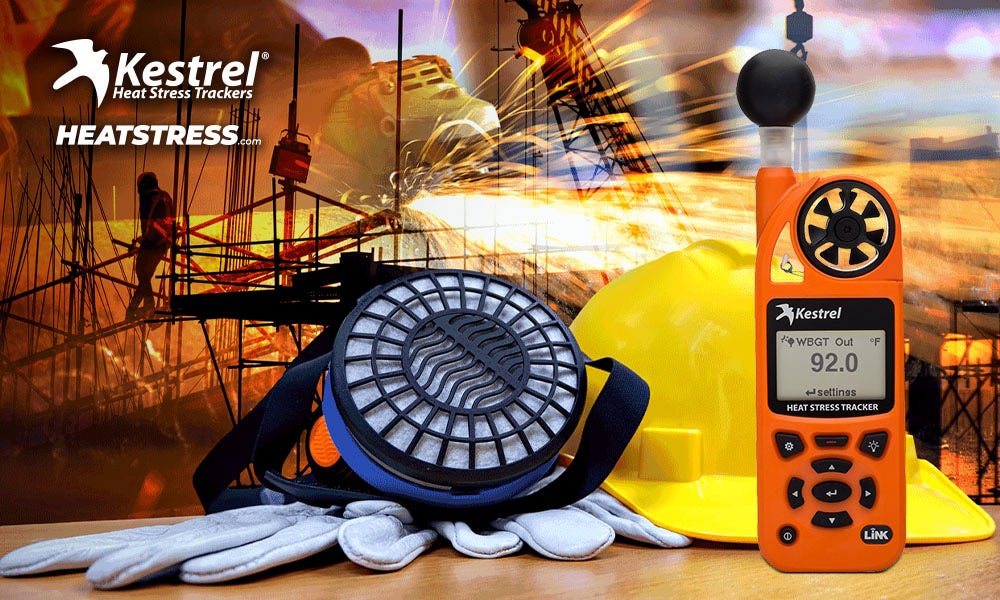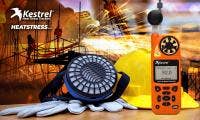What Is Heat Stress?

Heat stress is a critical health and safety concern when the body's ability to regulate its internal temperature is compromised due to prolonged exposure to excessive heat and humidity. This can lead to serious health conditions, including heat exhaustion, heat stroke, dehydration, and other heat-related illnesses.
Understanding heat stress and its causes and recognizing its signs and symptoms can help prevent these dangerous health impacts in industrial, military, agricultural, and athletic settings. Proactive measures, such as regular hydration, proper cooling strategies, and accurate monitoring tools, are essential to mitigating these risks effectively.
Understanding Heat Stress
Heat stress occurs when external environmental conditions (high temperature, high humidity, intense physical activity, or inadequate ventilation) overwhelm the body's natural cooling mechanisms—primarily sweating and blood flow to the skin. Factors such as lack of acclimatization to heat, inadequate hydration, and restrictive clothing can further exacerbate the risk. When this occurs, internal body temperatures begin to rise to dangerous levels, potentially causing serious harm or even death if not promptly recognized and addressed.
How Heat Stress Affects the Body
Heat stress negatively impacts the body's internal systems, resulting in various health issues. These conditions can range from mild discomfort to severe medical emergencies if not promptly managed.
Heat Exhaustion
Heat exhaustion occurs when the body loses excessive fluids and salts due to heavy sweating.
Symptoms include:
- Heavy sweating
- Weakness and fatigue
- Dizziness or fainting
- Nausea
- Cool, moist skin
- Muscle cramps
If left untreated, heat exhaustion can progress to heat stroke.
Heat Stroke
Heat stroke is the most severe form of heat-related illness and is considered a medical emergency. It occurs when the body's internal temperature rises rapidly, and the body loses its ability to cool down.
Symptoms include:
- High body temperature (above 103°F/39°C)
- Hot, dry skin or profuse sweating
- Rapid, strong pulse
- Headache
- Confusion, disorientation, or loss of consciousness
- Seizures
Immediate medical intervention is essential to prevent permanent damage or death.
Dehydration
Dehydration is a common effect of heat stress, occurring when fluid loss exceeds fluid intake.
Signs of dehydration include:
- Dry mouth
- Reduced urination
- Dark urine
- Extreme thirst
- Headache
- Dizziness
Dehydration can exacerbate other heat-related conditions and significantly reduce physical and cognitive performance.
Common Causes of Heat Stress
Heat stress is prevalent in environments where heat and humidity are high, physical labor is intense, or protective clothing limits cooling. Effective management requires awareness of environmental conditions and proactive strategies to mitigate risks.
Workplace
Industrial and agricultural workers frequently encounter conditions conducive to heat stress.
Causes include:
- Poor ventilation in factories and warehouses
- Outdoor work in direct sunlight
- Operation of machinery or equipment emitting high heat
- Heavy protective clothing or gear limiting heat dissipation
Military
Military personnel face unique risks for heat stress due to:
- Intense physical training and combat simulations
- Deployment in hot climates
- Heavy uniforms and equipment
- Limited opportunities for hydration and rest
Athletics
Athletes often experience heat stress when:
- Practicing or competing in hot, humid conditions
- Engaging in prolonged physical activity without adequate hydration breaks
- Wearing uniforms or gear that traps heat
Definitions from OSHA, NIOSH, and the Department of Defense
Several key U.S. organizations have defined heat stress to enhance understanding and provide guidance:
Occupational Safety and Health Administration (OSHA)
OSHA defines heat stress as the overall heat load a worker may be exposed to from the combined contributions of metabolic heat, environmental factors, and clothing requirements. OSHA emphasizes employers' responsibility to prevent heat-related illnesses through proper workplace practices, including providing water, rest breaks, shaded or cool areas, and comprehensive training programs for workers.
National Institute for Occupational Safety and Health (NIOSH)
NIOSH considers heat stress conditions in which the total heat load on the body exceeds the body's capacity to dissipate heat, resulting in adverse physiological responses. To prevent heat illness, NIOSH provides guidelines for work/rest cycles, hydration, and acclimatization, including the recommendation of gradual exposure to hot environments to build heat tolerance and reduce risk.
Department of Defense (DoD)
The DoD defines heat stress as the physiological strain and resulting risk associated with excessive heat and humidity exposure during military operations. To ensure safety and effectiveness, the DoD sets rigorous heat management standards for military training and deployments. These standards include regular monitoring of personnel, mandatory hydration and rest periods, comprehensive heat stress training, and using monitoring equipment to measure environmental conditions accurately.
Signs & Symptoms of Heat-Related Illnesses
Recognizing the early signs of heat stress can significantly reduce severe health outcomes.
Common indicators include:
- Excessive sweating or, conversely, cessation of sweating
- Muscle cramps or spasms
- Weakness, fatigue, and dizziness
- Rapid heartbeat
- Pale, clammy skin or hot, red skin
- Nausea, vomiting, or diarrhea
- Headaches
- Confusion or disorientation
- Loss of consciousness
Early intervention is crucial. If symptoms persist or worsen, affected individuals should be moved to a cooler environment, hydrated, and given medical attention.
Importance of Monitoring Heat Stress
Effective heat stress management involves consistently monitoring environmental conditions, including temperature, humidity, and airflow.
Specialized heat stress meters and monitoring devices play a critical role in:
- Measuring Wet Bulb Globe Temperature (WBGT)
- Assessing environmental risks
- Informing guidelines for rest, hydration, and cooling breaks
These meters typically measure ambient air temperature, humidity levels, wind speed, and solar radiation, providing a comprehensive picture of environmental conditions that contribute to heat stress. Real-time monitoring and accurate data collection enable employers, coaches, and supervisors to make informed decisions swiftly, such as implementing cooling strategies or adjusting work/rest cycles. By facilitating early interventions, these tools can greatly reduce heat-related illnesses. Accurate heat stress monitoring solutions significantly mitigate risk, ensure regulatory compliance, and protect health and productivity in occupational and athletic settings.
Understanding heat stress thoroughly, recognizing its risks, and utilizing proper tools and strategies can substantially reduce heat-related incidents, maintaining safer, healthier environments for everyone.





